A few years ago, I was inspired by a short video of a man creating a small boat from recycled plastic bottles. Despite searching everywhere, I couldn’t find any instructions on how to make one myself, so I set out without much guidance. I decided it would make a great dorm project because it was unique, messy, and totally harmless.
This is an entertaining way to reclaim and recycle those pesky plastic beverage bottles that always seem to be lying around, and it always turns a few heads on the lake. Plus, it’s recyclable!
How to make a boat from plastic bottles
The boat I made resembles an open-topped kayak. It measures approximately 3 x 7.5 feet and weighs roughly 50 lbs. Because the lids of the bottles are twisted on tightly, they keep the boat afloat, even if it’s swamped with water, so it’s basically self-bailing! It’s perfect for flat water and surprisingly durable, but I wouldn’t advise anyone to try even small rapids with it.
Step 1: Materials
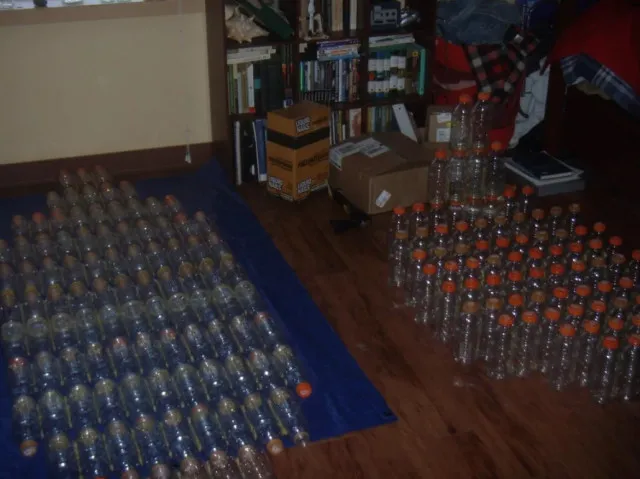
You will need just three things:
- Plastic bottles with lids tightly in place (about 270). I used 20 oz. sports drink bottles because of their size and durable construction.
- Adhesive. I used Liquid Nails polyurethane adhesive. I tried using silicone caulking, but it wasn’t sticky enough. There are likely better options.
- Caulking gun
Step 2: The Deck
The deck design resembles a simple flat-bottomed boat or one of those open kayaks you can buy at sporting goods stores. We’re going to make a few flat, raft-like layers and stack them on top of one another. Start by gluing bottles side by side in neat sections. When working with adhesives, ensure good ventilation. The glue I used didn’t have a strong scent, but it’s always better to be safe. A line of adhesive about 3/16” – 1/4″ wide is sufficient. You need a total of 12 horizontal sections for the deck of the boat. The sizes of sections are:
- 6 x 11 bottles
- 2 x 9 bottles
- 2 x 5 bottles
- 2 x 3 bottles
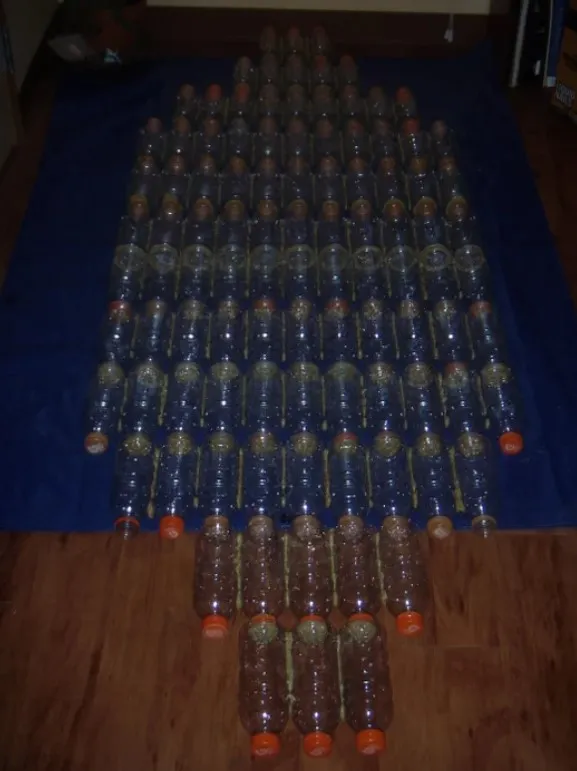
Step 3: The Hull
Once these sections are glued, allow the adhesive to cure according to the instructions on the tube. While you’re waiting for them to cure, you can begin assembling the next layer of the boat, which will act as the hull. It’s going to be slightly smaller than the first layer but constructed similarly. You need 11 horizontal sections for the second layer. Their sizes are:
- 5 x 10 bottles
- 2 x 8 bottles
- 2 x 4 bottles
- 2 x 2 bottles
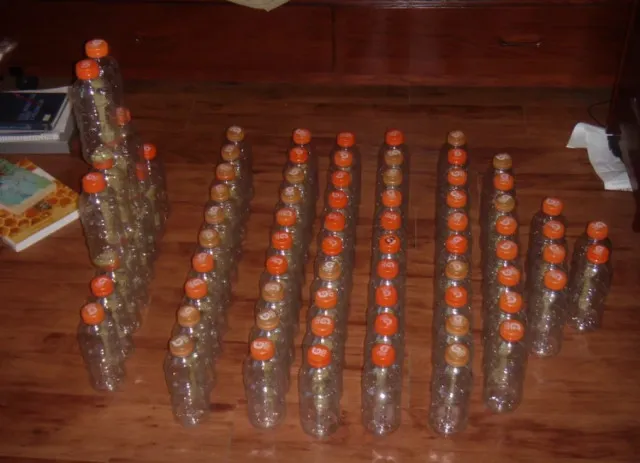
Step 4: Assembly
After you have allowed all the sections to cure, begin gluing them end to end. Place a big glob of adhesive in the bottom of each bottle and squish the caps of the adjoining section into it. You want the smallest sections at the ends and the largest sections in the middle, to approximate an ellipse, as in the highly technical diagram above.
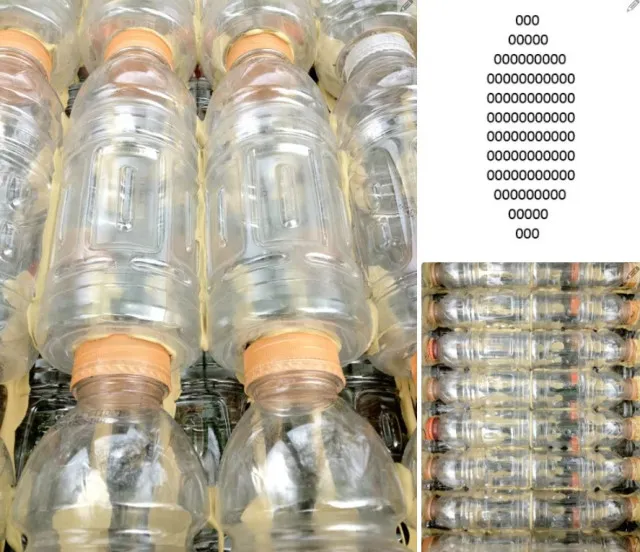
Keep the bottle caps facing towards the end of the boat until you get to the 6th section. At the 6th section, glue the 7th section with the bottle caps facing the opposite end of the boat. You want the caps in the back half facing the “stern” and the caps in the front half facing the “bow.” Allow this layer to cure.
Step 5: More Assembly
Once the base layer has cured, begin gluing the second layer on top of it. These bottles should be glued into the shallow “V” between each bottle of the base layer. Additionally, each section of the second layer should be offset so that it touches two sections of the base layer, as shown in the picture. This second layer acts as the bottom of the boat and gives it a rough “hull” shape.
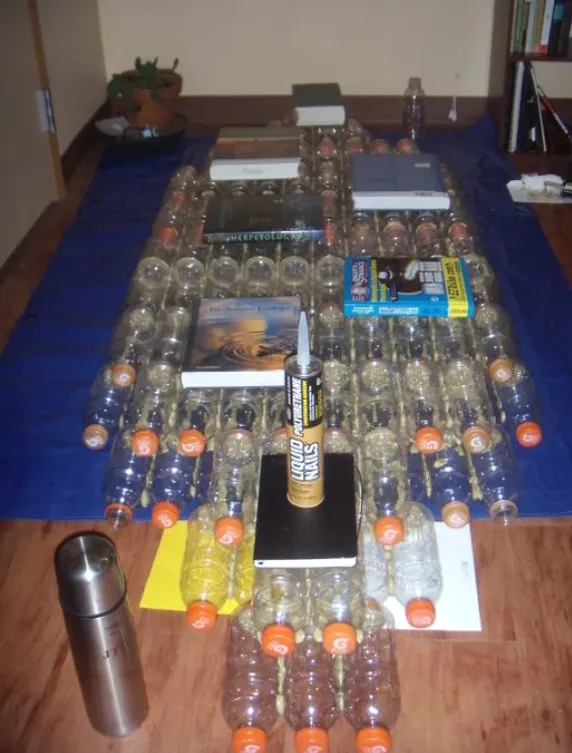
Press the sections together tightly with heavy books, weights, or slow-moving relatives and allow to cure.
Step 6: The Seat
Next, make the seat. You will need to construct a 2 x 11 section of bottles and glue it in position on top of the larger layer of bottles. You may choose to put it in the center of the boat or just behind the center, depending on your size. It should be noted that this seat is really uncomfortable, so you’ll probably want to supplement it with a nice foam cushion or at least a folded-up towel.
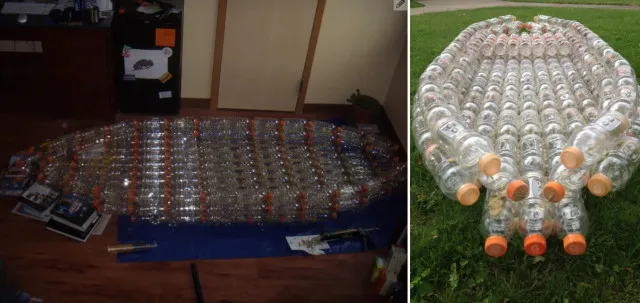
Step 7: The Final Step!
Finally, you must construct the gunwales. The gunwales are the railings that go around the edge of the boat. In this project, they are useful for carrying the boat and reducing the amount of water that splashes in. Glue two rows of bottles side by side around the edges of the largest layer, being sure to gently curve them to a point at the bow and stern. After you have glued these in place, add one more row of bottles on top of the gunwales for additional height and splash protection.
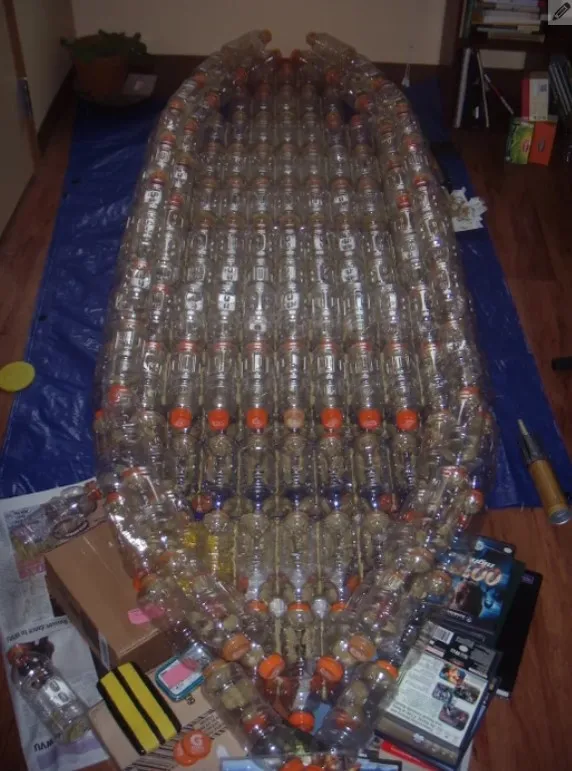
Step 8: Completion
Now you’re ready to take it out on the water. By far the best method of paddling is a regular kayak paddle. I’ve used a canoe paddle before, but it’s significantly more difficult to keep the boat going straight. I weigh about 180 pounds, and what might be called the “deck” of the boat sits just above water level. If you’re any heavier than me, you may want to consider adding a third layer of bottles to the hull. This should provide you with enough buoyancy to keep you from getting too wet. Keep in mind, though, this is just a glorified bath toy and I wouldn’t expect to stay very dry while using it.
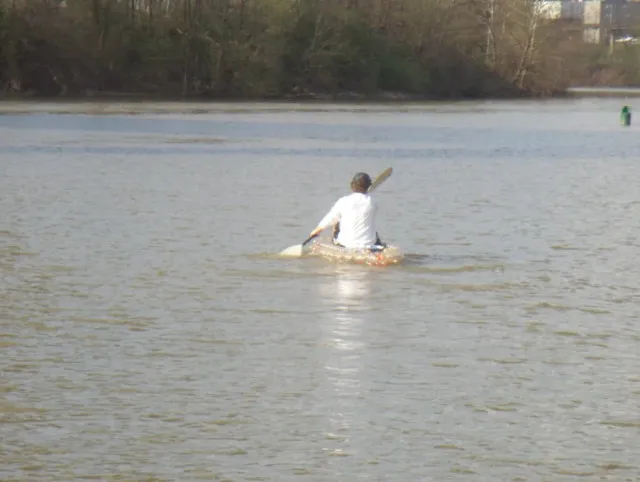
My hope is that this guide helps you in constructing your own boat from recycled bottles. Feel free to ask me any questions if it isn’t clear enough, and please get creative with your own design (I’m hoping for a Viking longboat). Have fun and good luck!
A Note on Repair and Recycling
If a bottle gets punctured or damaged, it’s easy to replace. First, carefully cut it out using a utility knife. Next, peel off the old glue. This can usually be done by hand, but you may need to scrape off stubborn bits with the knife or sandpaper. Finally, just glue a new bottle in its place!
Read more 15 surprising discoveries that leave you wondering why
If you wish to recycle the bottles used in this project, you’ll need to disassemble the boat. This is a courteous gesture to your local recycling plant workers who don’t want to deal with a large, unwieldy object. It’s also necessary. The glue must be removed before the plastic can be recycled. The adhesive I used can be peeled off by hand. Sand off any stubborn bits, or cut those sections out of the bottle.